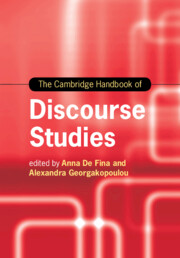Book contents
- The Cambridge Handbook of Discourse Studies
- Cambridge Handbooks in Language and Linguistics
- The Cambridge Handbook of Discourse Studies
- Copyright page
- Contents
- Figures
- Tables
- Contributors
- Preface
- Part I (Con)Textualizing Discourses
- Part II Perspectives and Modes of Analysis
- Part III Discourse Materialities and Embodiment
- 12 Multimodality
- 13 Sign Theory and the Materiality of Discourse
- 14 Discourse and the Linguistic Landscape
- 15 Discourse, Emotions and Embodiment
- 16 Posthumanism and Its Implications for Discourse Studies
- Part IV (Trans)Locations and Intersections
- Part V Ethics, Inequality and Inclusion
- Part VI Discourses, Publics and Mediatization
- Index
- References
15 - Discourse, Emotions and Embodiment
from Part III - Discourse Materialities and Embodiment
Published online by Cambridge University Press: 28 September 2020
- The Cambridge Handbook of Discourse Studies
- Cambridge Handbooks in Language and Linguistics
- The Cambridge Handbook of Discourse Studies
- Copyright page
- Contents
- Figures
- Tables
- Contributors
- Preface
- Part I (Con)Textualizing Discourses
- Part II Perspectives and Modes of Analysis
- Part III Discourse Materialities and Embodiment
- 12 Multimodality
- 13 Sign Theory and the Materiality of Discourse
- 14 Discourse and the Linguistic Landscape
- 15 Discourse, Emotions and Embodiment
- 16 Posthumanism and Its Implications for Discourse Studies
- Part IV (Trans)Locations and Intersections
- Part V Ethics, Inequality and Inclusion
- Part VI Discourses, Publics and Mediatization
- Index
- References
Summary
Increasingly, bodies and emotions have become a topic of systematic engagement in a number of academic disciplines. Starting from psychology and neuroscience, this interest – sometimes framed in terms of “affective turn” or “body turn” – has made its way into social and cultural studies and, to some extent, into applied linguistics. The recent “rediscovery” of bodies and emotions can, however, draw on earlier conceptions linking body, emotion and language such as the emotive function of language, the interactional enactment of bodies and affects, the notions of hexis and habitus, the discursive production of bodies and of emotions, the bodily rootedness of metaphors or the distinction between (perceived) body-object and (perceiving) body-subject. The interest of applied linguistics in emotions and embodiment can be seen as clustered around three basic questions: (1) How are bodies and emotions performed in verbal interactions? (2) How are they formed or constructed in social practices and discourses? (3) How are they involved in processes of experiencing and enregistering communicative events? As I argue, these three aspects cannot be dealt with separately as, in all of them, power relations and language ideological processes of positioning oneself and being positioned by others are at stake. The interrelations between discourse, emotions and embodiment will be approached from different epistemological angles: interactional approaches focusing on the observation of situated communicative events on a micro level; discourse theory approaches investigating the discursive objectification of subjects and subjectivities in a historical perspective; phenomenological approaches taking the idea of the acting and experiencing body-subject as starting point. Special attention is given to issues currently debated such as the production of racialized, gendered or disabled bodies as well as to concepts such as emotion in positioning or in stancetaking, embodied sociolinguistics or the lived experience of language.
- Type
- Chapter
- Information
- The Cambridge Handbook of Discourse Studies , pp. 327 - 349Publisher: Cambridge University PressPrint publication year: 2020
References
Further Reading
This chapter offers a well-founded overview of key questions in sociolinguistics from the angle of body and embodiment. It deals with topics such as embodied indexicality, style as embodied self-presentation, embodied discourse and embodied agency.
The concept of bodily and emotionally lived experience of language is developed in detail and grounded in post-structuralist and phenomenological thinking.
This is one of Goodwin’s famous studies on how interactants make use of their bodies and display affects to achieve collaborative action. It is based on a sequence in which a father is helping his daughter do homework.
The book analyzes personal experiences of language through the voices of Mexican immigrant women in the United States, in relation to racialization discourses. The author emphasizes that the interactional dimension of emotions is a central linguistic device not only found in constructed dialogues (reported speech) but also emergent in the whole narrative structure.
This book presents a new social science understanding of affect and emotion and offers insights into approaches from psycho, neuro, bio and social sciences.
References
- 7
- Cited by



